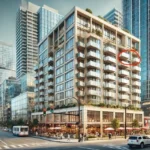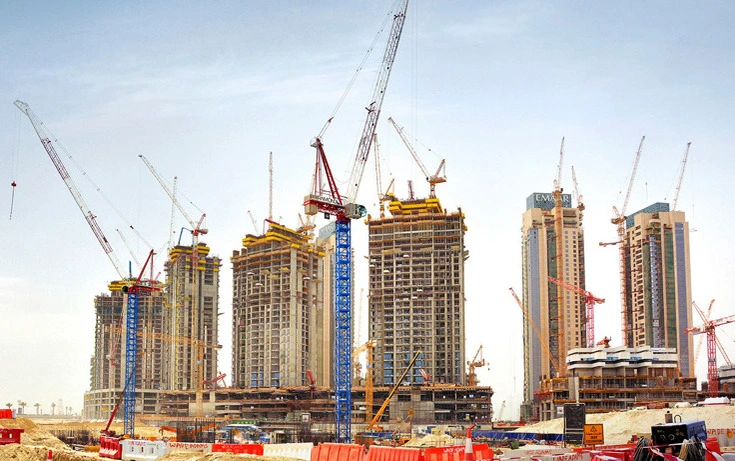TL;DR: Dubai’s real estate scene in 2025 is hotter than ever. But is it really the golden opportunity many think it is—or are you walking into an oversupplied, overpriced trap? I toured dozens of projects, nearly pulled the trigger on one, and walked away with hard-earned insights every investor should know.
1. Why Dubai Caught My Attention (Despite My Initial Doubts)
Before this trip, Dubai wasn’t even on my investment radar. The hype, the luxury overload, the off-plan frenzy—it felt too overheated. But when a close friend invited me to tag along, I took the chance to explore for myself.
And that’s when I started looking at what really matters: demographics, economic drivers, infrastructure, and global positioning. Because if the foundations are weak, all the glass towers in the world won’t save your investment.
✅ Dubai’s Population Boom 👌
Dubai’s population growth is explosive:
- 2000–2010: Grew from 862,000 to 1.9 million
- 2015–2023: Surged to 3.65 million
- 2040 forecast: Over 6 million
- This kind of demand means more need for housing, infrastructure, and commercial space.
✅ Tourism Explosion: From Desert Stopover to Global Magnet 👌
Tourism fuels short-term rentals—and Dubai’s numbers are wild:
- 1982: 374,400 visitors
- 2000: 3 million
- 2010: 8.4 million
- 2019: 16.7 million
- 2024: 18.72 million (record-breaking)
- Target: 25+ million annually
✅ Economic Diversification = Long-Term Resilience 👌
GDP breakdown (2024):
- Wholesale & Retail: 24.5%
- Finance & Insurance: 11.6%
- Transport: 12%
- Manufacturing: 9%
- Real Estate & Construction: 13% combined
- Tourism: 12%
- Oil & Gas: Less than 1%
Very well-balanced. That’s what future-proofing looks like.
✅ Infrastructure for 2035, Not 2025 👌
- Al Maktoum Airport: Set to be the world’s largest airport
- Green Spine: 40-mile solar tram corridor with 1M trees
- Smart city tech: Ranked #12 globally
- 2025 budget: 46% allocated to infrastructure
✅ Geopolitical Advantage 👌
- Neutral, stable, and business-friendly (far away from the heated political war between China, Europe, and USA)
- Bridge between East and West—doing deals with everyone
- 2024: UAE added 6,700 millionaires + 18 billionaires
- Private wealth grew 39.5% to $138.7B
🏆 With all the right macro drivers in place, Dubai is shaping up to be a top-tier destination for real estate investors. It has the momentum, the money, and the market 💯.
2. The Good: Why Investors Are Still Pouring Into Dubai

Next to all the favorable macro factors above, Dubai also offers some very unique advantages that almost nowhere else in the world can match—especially when it comes to investor-friendly policies, strong returns, and ease of doing business.
- Zero tax on personal income, capital gains, and wealth
- Rental yields of 6–9% or even higher(especially with Airbnb)
- Golden Visa from AED 2M (~$545K)
- 100% foreign ownership in most zones
- High liquidity and fast transactions
- Global city status—airport, shopping, safety, lifestyle
- Business-friendly government with no red tape
Name me another city where you get 0% income tax, 0% capital gains tax, 0% wealth tax, 100% foreign ownership, high liquidity, double-digit rental yields—and still live in a modern, global city with beach views and metro access?
Now let’s compare:
Hong Kong – Once a tax haven, now faces rising political pressure, tighter regulation, and a cooling property market. Plus, 15% stamp duty for non-residents makes entry pricey.
Singapore – Safe and stable, yes. But property taxes, high entry prices, and Additional Buyer’s Stamp Duties (up to 60% for foreigners on second homes) make it far less investor-friendly.
Cayman Islands, Seychelles, Vanuatu – Sure, there are tax perks. But good luck flipping or renting out your property at scale—these aren’t global cities with real liquidity or year-round rental demand. You’re parking money, not growing it.
🏆 Dubai offers the rare combination of low tax, full ownership, fast exit options, investor incentives, and real rental cash flow— all in one place.
3. The Bad: What Most People Don’t Realize Until It’s Too Late
💡 Pro tip for new investors: Dubai’s short-term rental market is regulated. You need a holiday home license to operate Airbnb legally in most areas. Factor that into your returns before buying.
On paper, Dubai looks like a real estate dream. But behind the glossy brochures and booming skyline are risks most investors overlook—until it’s too late. Here’s what you won’t hear in most sales pitches:
❌ Oversupply is real: Dubai’s skyline is expanding at breakneck speed. Construction cranes dominate every district. But more towers often mean more competition—and thinner margins.
❌ Air and noise pollution: Many fast-growing neighborhoods are construction zones, filled with dust, noise, and visual clutter. Quality of life (and tenant satisfaction) can take a hit.
❌ Off-plan overload: Off-plan projects are everywhere, often aggressively marketed with “limited time” offers. But oversaturation in this segment can undercut both resale and rental value when too many similar units hit the market at once.

❌ High entry point: What $250K bought you five years ago—a spacious 1BR or 2BR in a great neighborhood—now barely covers a studio. As prices rise, finding strong ROI at entry-level budgets becomes tougher.
❌ Rapid deterioration: Dubai’s extreme heat, sand, and sun wear down buildings quickly. Budget extra for faster-than-expected maintenance—especially if you’re buying mid-range builds.
❌ High transaction costs: Between the 4% DLD fee, 2% agent commission, and annual service charges, costs can eat into your ROI fast. Always calculate total acquisition and holding costs.
❌ Built for the ultra-rich: With luxury projects dominating the skyline, much of Dubai’s market caters to ultra-high-net-worth buyers—not everyday investors. The wealth gap is real, and it shapes pricing, marketing, and even zoning.
❌ The obsession with “new”: Dubai’s off-plan culture feeds a constant hunger for the latest launch. But when your unit is no longer “brand new,” it may struggle to compete—unless you’ve bought something truly unique.
⚠️ Bottom line: Don’t let the glitz blind you. Dubai can be a profitable market—but only if you know where to look and what to avoid.
4. Is Dubai Oversupplied? Let’s Look at the Facts
It’s the question nearly every investor asks the moment they land in Dubai: Is this city oversupplied?
As my friend and I toured different districts, met with developers, and walked through dozens of projects, one thing stood out—everywhere we turned, towers were rising. Cranes filled the skyline. Scaffolding wrapped around half-finished high-rises. It felt like the entire city was under construction. It was awe-inspiring… but also deeply unsettling.
And one concern kept coming up, again and again: oversupply.
Population Growth vs. Housing Supply: What the Numbers Really Say
Let’s break it down in plain terms.
Dubai’s population is growing fast:
2024 population: Around 3.825 million people
Population growth in 2024: +169,000 people (the biggest jump in 6 years)
2040 target population: 5.8 million (but that growth will be gradual, over 15+ years)
Now look at the housing supply:
Total residential units in 2024: ~757,500
New units delivered in 2024: 38,500
Units expected in 2025: 74,494
Units expected in 2026: 114,402 (record-breaking)
Units expected in 2027: 70,465
That’s almost 260,000 new homes being added in just three years.
So here’s the key question:
Is Dubai actually adding 250,000+ new permanent residents by 2027 to fill all of those homes?
Let’s say each household has 3.5 people (the current citywide average). Just the 2024 supply alone could house around 135,000 people—which already matches that year’s entire population growth.
But here’s the issue:
Most new units are studios and 1-bedrooms aimed at singles or couples, where the average household size is closer to 1–2 people. That means the effective capacity is much lower.
So the problem isn’t just how many homes are being built—
It’s who they’re being built for.
Tourism Helps—but Won’t Absorb Everything
Dubai’s tourism boom adds demand:
2024: Nearly 19 million visitors
Goal: 25M/year
That supports Airbnb-style rentals—but only if your unit is:
Central and walkable
Near a metro, mall, or tourist hub
Designed with amenities like a hotel
Tourists won’t save poorly located, generic projects outside the action. And don’t forget—Dubai already offers an incredible range of hotels, from ultra-luxury resorts to budget-friendly stays. There’s something for every traveler, which makes it even tougher for average short-term rentals to stand out.
To put it in perspective:
New York City had 3.4 times more tourists than Dubai—62.2 million in 2023, 65 million in 2024, and a projected 68 million in 2025.
Yet, New York has 26% fewer hotel rooms than Dubai (120,000 vs. 151,245).
(Source: Coohom, Statista, Gulf Business)
And that doesn’t even include the thousands of new hotel rooms currently under construction in Dubai. In other words—competition is only heating up.
The Real Risk: Segment Saturation
From everything I saw on the ground and confirmed through the data, oversupply in Dubai isn’t a blanket issue—but it’s a serious one in the high-end studio and 1-bedroom segment.
And let’s be honest: this is the exact category most retail investors, including myself, gravitate toward. It’s the familiar formula—low entry cost, high rental yield.
But in Dubai 2025? That segment is oversaturated.
The entry cost is no longer low, and the competition is fierce. You’re up against:
❌ Thousands of already existing and available units
❌ Dozens of near-identical off-plan launches
❌ Newer, glossier units with better amenities
❌ Hotels with strong brand recognition and service
❌ Better-located, better-designed alternatives
In both the short- and long-term rental markets, the differentiation game is brutal. Even a prime location can’t save you if your unit doesn’t offer anything unique.
So, is the market oversupplied? Not everywhere. But if you’re going after the same small-format investment product as everyone else, you’re entering a crowded arena with shrinking margins.
⚠️ So, is the market oversupplied? Not everywhere. But if you’re going after the same small-format investment product as everyone else, you’re entering a crowded arena with shrinking margins.
5. Where I Still See Opportunity in Dubai
1. Affordable Housing for Low-Income Immigrants
This segment is often overlooked but has massive demand. Dubai runs on its low-skilled immigrant workforce—from construction workers to delivery riders—and they all need a place to live.
With the right setup, you could either:
- Buy an entire floor in an existing building, or
- Build your own small-scale apartment block
Why it works:
You’ll never worry about vacancy. The demand is constant.
But the downside?
These are low-income tenants, so expect:
- Higher wear-and-tear
- Faster deterioration of interiors
- Ongoing maintenance headaches if the property isn’t managed well
It’s profitable—but definitely not passive.
2. Ultra-Luxury Segment (The Top 1%)

As high-net-worth individuals flood into Dubai, the demand for ultra-luxury homes has soared—but supply hasn’t kept up.
📉 Listings for homes over $10 million have dropped by 65% over the past year—down to just 460 properties.
📉 Listings for homes over $25 million? Down 85%, with only 86 units left.
Source: LinkedIn – Dubai Luxury Homes Market
If you’re playing in that league, scarcity is your friend. The top-tier market is tight, and buyers are willing to pay a premium for the right view, layout, and address.
3. Metro-Accessible Mid-Market Condos (Lower Price, Higher ROI)
Now, this is the option that makes the most sense for smaller investors like me.
Look for a well-built, decent-sized condo that’s within walking distance to a metro station. It doesn’t have to be in the most expensive district—just accessible, safe, and convenient.

Why this works:
- Easy to rent out for both short-term and long-term
- Lower entry cost compared to city-center luxury units
- Appeals to working professionals, digital nomads, and budget-conscious travelers
And let’s bust a common myth while we’re at it:
You’ll hear people online say, “But rich people don’t take the metro in Dubai.”
So what?
Normal people do—and they make up 80% of Dubai’s population.
We took the metro everywhere during our trip, just to test it out. And honestly? It was clean, safe, efficient, air-conditioned, and on time. There’s even a separate carriage for women. Compared to taxis or Careem (Dubai’s version of Uber), it was insanely affordable.
And here’s the kicker: no matter what time we boarded, it was always full.
So don’t let some Instagram influencer convince you that the metro doesn’t make any difference—or that it’s only for the poor. That couldn’t be further from the truth. Metro-accessible units are highly desirable and only becoming more valuable as the city grows denser and traffic gets worse.
7. Final Thoughts: Who Should (and Shouldn’t) Invest in Dubai
✅ Consider investing if:
- You want tax-free income
- You want to diversify your investment portfolio
- You have cash and can hold 3–5 years
- You understand off-plan risks and have time to research
❌ Avoid for now if:
- You’re highly risk-averse
- You can’t physically visit and verify projects
- It’s your first time investing (maybe it’s a better idea to practice in your home country first)
How about you?
Have you invested in Dubai—or are you thinking about it? Share your story below—I’d love to hear how it’s going.
👉 Up Next: The Deal That Almost Happened
In my next blog, I’ll take you inside a real estate deal in Dubai that came this close to happening. We were ready to sign, the numbers looked solid, the pitch was polished—until we uncovered what no brochure or agent told us.
Why we bailed, what we learned, and how it could save you from making the same mistake.
If you’re thinking about investing in Dubai, you won’t want to miss this.
Related posts:
 We Almost Bought TWO Off-Plan Apartments in Dubai—Here’s Why We Walked Away
We Almost Bought TWO Off-Plan Apartments in Dubai—Here’s Why We Walked Away
 Investing in Oman Real Estate in 2025: Hidden Gem or Risky Bet? | Full Investor Breakdown
Investing in Oman Real Estate in 2025: Hidden Gem or Risky Bet? | Full Investor Breakdown
 Oman Real Estate 2025: The $550K+ Villa in Muscat I Almost Bought (But Still Want)
Oman Real Estate 2025: The $550K+ Villa in Muscat I Almost Bought (But Still Want)
 Why I Walked Away From a $550K Off-Plan Villa in Oman
Why I Walked Away From a $550K Off-Plan Villa in Oman
 Part 6 (Final): Words of Caution
Part 6 (Final): Words of Caution
 How to Invest in Real Estate with Just $20K (2025) – Best Strategies & Smart Locations
How to Invest in Real Estate with Just $20K (2025) – Best Strategies & Smart Locations



